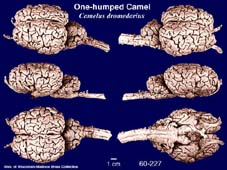|
One-humped
Camel
(Camelus dromedarius) #60-227 |
||||
|
|
Physical
characteristics and distribution
|
|
One-humped Camel Camelus dromedarius One-humped Camels are good transports due to their ability to go long periods without water. Their skins have very few sweat glands. Their coats are beige or pale brown, short, soft, and shed after the winter season. Their head and body length ranges from 225-345 cm and they weigh from 300-690 kg. One-humped Camels will eat any vegetation that grows in the desert. They can get enough water from desert vegetation and can survive a water loss exceeding 40 percent of their body weight. If need be, they will eat fish, flesh, bones and skin. They can withstand extreme heat and cold. They are also good swimmers with keen sight and a good sense of smell. Over a four-day period, a One-humped Camel can carry 170-270 kg at a rate of 47 km/day. At the time of mating two kinds of herds form: bachelor males, adult females with their new born, and adult females along with their one to two year olds led by the dominant male. The peak birth season is from February to May. A female One-humped Camel gives birth every other year having only one young after about a 405-day gestation period. When young males reach two years of age, they are forced to join the bachelor group by the dominant male. One-humped Camels inhabit only deserts. They are extinct in the wild; domesticated from wild populations which presumably had become restricted to the S Arabian Peninsula; domesticated in Senegal and Mauritania to Somalia and Kenya, throughout N Africa, the Middle East, Arabia, and Iran to NW India; feral populations in Australia. |
|
Description
of the brain
|
|
Animal
source and preparation
|
|
All
specimens collected followed the same preparation
and histological procedure.
|
Other Related Resources (websites and publications)
List of Specimens | Explore Collections | Brain Sections | Brain Evolution | Brain Development | Brain Circuitry | Brain Functions | Location and Use | Related Web Sites | Contact Us | Search MSU Database | Personnel | Home



